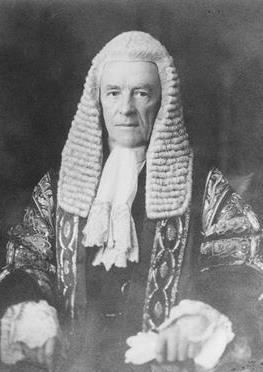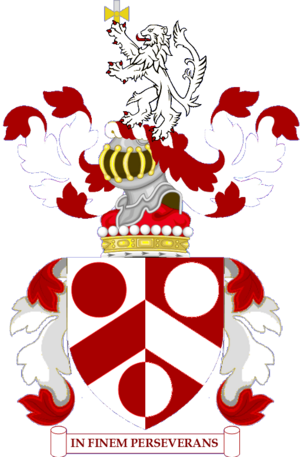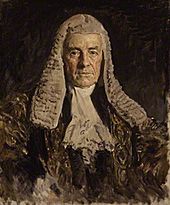Frederic Maugham, 1st Viscount Maugham facts for kids
Quick facts for kids
The Viscount Maugham
|
|
|---|---|
 |
|
| Lord High Chancellor of Great Britain | |
| In office 9 March 1938 – 3 September 1939 |
|
| Prime Minister | Neville Chamberlain |
| Preceded by | The Viscount Hailsham |
| Succeeded by | The Viscount Caldecote |
| Member of the House of Lords Lord Temporal |
|
| In office 7 October 1935 – 23 March 1958 Hereditary Peerage |
|
| Preceded by | Peerage created |
| Succeeded by | The 2nd Viscount Maugham |
| Personal details | |
| Born | 20 October 1866 Paris, France |
| Died | 23 March 1958 (aged 91) |
| Nationality | British |
| Political party | Conservative |
| Spouse |
Helen Romer
(m. 1896; died 1950) |
| Alma mater | Trinity Hall, Cambridge |
Frederic Herbert Maugham (born October 20, 1866 – died March 23, 1958) was an important British lawyer and judge. He held a very high position called Lord Chancellor from March 1938 to September 1939. He was also known as the 1st Viscount Maugham.
Early Life and Education
Frederic Maugham was born in Paris, France. He was the second son of Robert Ormond Maugham, who was a solicitor (a type of lawyer). His younger brother was the famous author W. Somerset Maugham. His grandfather, Robert Maugham, helped start the Law Society, which is an important group for lawyers in England.
Frederic went to Dover College and then to Trinity Hall, Cambridge University. He was a talented rower. He was part of the winning Cambridge team in the famous Boat Race in both 1888 and 1889. In 1888, his team also won the Stewards' Challenge Cup at the Henley Royal Regatta, a major rowing event. He also became the President of the Cambridge Union Society in 1889, which is a debating club.
Legal and Political Career
In 1890, Maugham became a barrister, which is a lawyer who argues cases in court. He joined Lincoln's Inn, one of the four professional associations for barristers in England. He became a King's Counsel in 1913, which is a special title for experienced barristers.
In 1922, he thought about becoming a Member of Parliament for the Conservative Party, but he didn't find a suitable area to represent.
He became a judge in the High Court of Justice from 1928 to 1934. Then, he was a Lord Justice of Appeal from 1934 to 1935. In 1928, he was knighted, which means he received the title "Sir." In 1934, he joined the Privy Council, a group of advisors to the King or Queen.
In 1935, he became a Lord of Appeal in Ordinary, a top judge in the House of Lords. He was given the title Baron Maugham and became a life peer, meaning he could sit in the House of Lords for the rest of his life.
Three years later, in 1938, Prime Minister Neville Chamberlain asked him to become the Lord Chancellor. This is a very important role, as the Lord Chancellor is the head of the justice system in the UK and a senior member of the government. Maugham was 71 years old at the time.
It was thought that Maugham would only be Lord Chancellor for a short time. However, Prime Minister Chamberlain was impressed with his work. Maugham served as Lord Chancellor until September 1939, when World War II began and the government changed.
When he retired, he was given a new, hereditary title: Viscount Maugham. This meant his title could be passed down to his children. He continued to serve as a Lord of Appeal in Ordinary until 1941.
Family Life
In 1896, Maugham married Helen Mary Romer. They had four children together:
- Kate Mary Maugham (1897–1961)
- Edith Honor Maugham (1901–1996)
- Diana Julia Maugham (1908–2007)
- Robert Cecil Romer Maugham (1916–1981), who became the 2nd Viscount Maugham. Robin Maugham later wrote books about his father.
Lady Maugham passed away in 1950. Lord Maugham lived for another seven years, dying in March 1958 at the age of 91. He is buried in Hartfield, East Sussex, with his wife and son.
See also
- List of Cambridge University Boat Race crews



